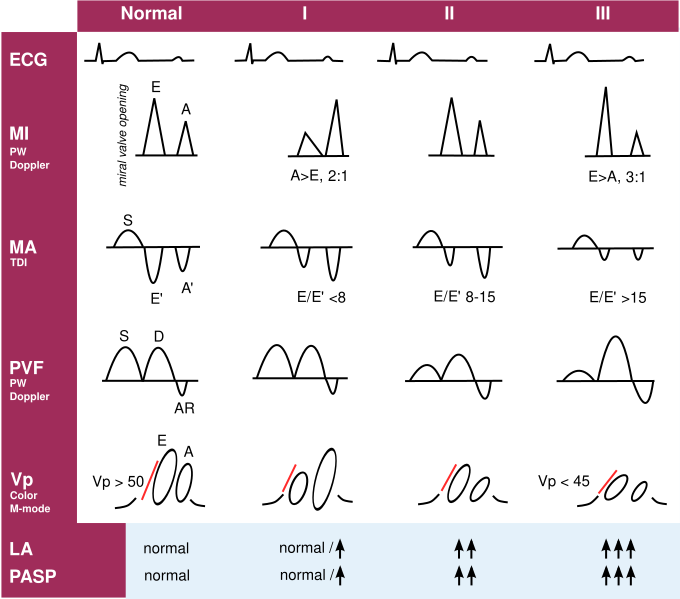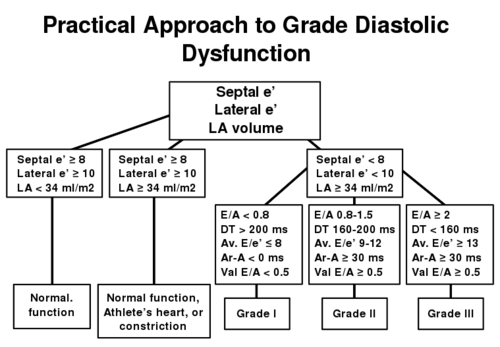Diastolic Function: Difference between revisions
Jump to navigation
Jump to search
No edit summary |
|||
| (10 intermediate revisions by 3 users not shown) | |||
| Line 1: | Line 1: | ||
==The Left | ==The Left Ventricle== | ||
There is still much uncertainty about the pathophysiology of diastolic heart failure, | There is still much uncertainty about the pathophysiology of diastolic heart failure, effective treatment has not surfaced yet while it has a similar high mortality and morbidity rate when compared to systolic heart failure. One of the characteristics of diastolic heart failure is an increased LV diastolic stiffness. There are several important measurements echocardiographic measurement to estimate cardiac diastolic performance. | ||
==Left ventricular diastolic function== | ==Left ventricular diastolic function== | ||
{| class="wikitable" cellpadding="0" cellspacing="0" border="0" width="800px" | |||
|- | |||
!colspan="6"| | |||
===Normal Values diastolic parameters=== | ===Normal Values diastolic parameters=== | ||
|- | |- | ||
!rowspan="2" valign="middle"|Measurement | !rowspan="2" valign="middle"|Measurement | ||
| Line 16: | Line 18: | ||
!>60 | !>60 | ||
|- | |- | ||
!IVRT (ms) | |||
|50 ± 9 (32-68) | |50 ± 9 (32-68) | ||
|67 ± 8 (51-83) | |67 ± 8 (51-83) | ||
| Line 22: | Line 24: | ||
|87 ± 7 (73-101) | |87 ± 7 (73-101) | ||
|- | |- | ||
!E/A ratio | |||
|1.88 ± 0.45 (0.98-2.78) | |1.88 ± 0.45 (0.98-2.78) | ||
|1.53 ± 0.40 (0.73-2.33) | |1.53 ± 0.40 (0.73-2.33) | ||
| Line 28: | Line 30: | ||
|0.96 ± 0.18 (0.6-1.32) | |0.96 ± 0.18 (0.6-1.32) | ||
|- | |- | ||
!DT (ms) | |||
|142 ± 19 (104-180) | |142 ± 19 (104-180) | ||
|166 ± 14 (138-194) | |166 ± 14 (138-194) | ||
| Line 34: | Line 36: | ||
|200 ± 29 (142-258) | |200 ± 29 (142-258) | ||
|- | |- | ||
!A duration (ms) | |||
|113 ± 17 (79-147) | |113 ± 17 (79-147) | ||
|127 ± 13 (101-153) | |127 ± 13 (101-153) | ||
| Line 40: | Line 42: | ||
|138 ± 19 (100-176) | |138 ± 19 (100-176) | ||
|- | |- | ||
!PV S/D ratio | |||
|0.82 ± 0.18 (0.46-1.18) | |0.82 ± 0.18 (0.46-1.18) | ||
|0.98 ± 0.32 (0.34-1.62) | |0.98 ± 0.32 (0.34-1.62) | ||
| Line 46: | Line 48: | ||
|1.39 ± 0.47 (0.45-2.33) | |1.39 ± 0.47 (0.45-2.33) | ||
|- | |- | ||
!PV Ar (cm/s) | |||
|16 ± 10 (1-36) | |16 ± 10 (1-36) | ||
|21 ± 8 (5-37) | |21 ± 8 (5-37) | ||
| Line 52: | Line 54: | ||
|25 ± 9 (11-39) | |25 ± 9 (11-39) | ||
|- | |- | ||
!PV Ar duration (ms) | |||
|66 ± 39 (1-144) | |66 ± 39 (1-144) | ||
|96 ± 33 (30-162) | |96 ± 33 (30-162) | ||
| Line 58: | Line 60: | ||
|113 ± 30 (53-173) | |113 ± 30 (53-173) | ||
|- | |- | ||
!Septal e´ (cm/s) | |||
|14.9 ± 2.4 (10.1-19.7) | |14.9 ± 2.4 (10.1-19.7) | ||
|15.5 ± 2.7 (10.1-20.9) | |15.5 ± 2.7 (10.1-20.9) | ||
| Line 64: | Line 66: | ||
|10.4 ± 2.1 (6.2-14.6) | |10.4 ± 2.1 (6.2-14.6) | ||
|- | |- | ||
!Septal e´/a´ ratio | |||
|2.4* | |2.4* | ||
|1.6 ± 0.5 (0.6-2.6) | |1.6 ± 0.5 (0.6-2.6) | ||
| Line 70: | Line 72: | ||
|0.85 ± 0.2 (0.45-1.25) | |0.85 ± 0.2 (0.45-1.25) | ||
|- | |- | ||
!Lateral e´ (cm/s) | |||
|20.6 ± 3.8 (13-28.2) | |20.6 ± 3.8 (13-28.2) | ||
|19.8 ± 2.9 (14-25.6) | |19.8 ± 2.9 (14-25.6) | ||
| Line 76: | Line 78: | ||
|12.9 ± 3.5 (5.9-19.9) | |12.9 ± 3.5 (5.9-19.9) | ||
|- | |- | ||
!Lateral e´/a´ ratio | |||
|3.1* | |3.1* | ||
|1.9 ± 0.6 (0.7-3.1) | |1.9 ± 0.6 (0.7-3.1) | ||
| Line 83: | Line 85: | ||
|- | |- | ||
|colspan="6"| | |colspan="6"| | ||
*Data are expressed as mean ± SD (95% confidence interval). Note that for e´ velocity in subjects aged 16 to 20 years, values overlap with those for subjects aged 21 to 40 years. This is because e´ increases progressively with age in children and adolescents. Therefore, the e´ velocity is higher in a normal 20-year-old than in a normal 16-year-old, which results in a somewhat lower average e´ value when subjects aged 16 to 20 years are considered. | *Data are expressed as mean ± SD (95% confidence interval). Note that for e´ velocity in subjects aged 16 to 20 years, values overlap with those for subjects aged 21 to 40 years. This is because e´ increases progressively with age in children and adolescents. Therefore, the e´ velocity is higher in a normal 20-year-old than in a normal 16-year-old, which results in a somewhat lower average e´ value when subjects aged 16 to 20 years are considered.<cite>1</cite> | ||
*<nowiki>*</nowiki>Standard deviations are not included because these data were computed, not directly provided in the original articles from which they were derived. | *<nowiki>*</nowiki>Standard deviations are not included because these data were computed, not directly provided in the original articles from which they were derived. | ||
|} | |} | ||
{| class="wikitable" cellpadding="0" cellspacing="0" border="0" width="800px" | |||
|- | |||
! | |||
===Schematic diastolic filling patterns=== | ===Schematic diastolic filling patterns=== | ||
|- | |||
|'''A patient with dyspnea, preserved systolic LV function, dilated left atrium and elevated pulmonary artery systolic pressure, without any significant mitral valve disease that could explain these findings, is the patient that requires an intensified search for diastolic LV dysfunction.''' | |||
|- | |||
|align="center" bgcolor="FFFFFF"|[[Image:Diastole.svg]] | |||
|- | |||
|'''I:''' impaired relaxation, '''II:''' moderate diastolic dysfunction (pseudonormal), '''III:''' restrictive left ventricular filling (impaired LV compliance), ECG: electrocardiogram, MI: mitral inflow, MA: mitral annular velocities, PVF: pulmonary venous flow, Vp: velocity of flow progression, LA: left atrium, PASP: pulmonary artery systolic pressure.<cite>2</cite> | |||
[ | Click [http://www.ecocardiografia.info/didat_diast_en_II.htm '''here'''] for animation on diastolic dysfunction | ||
|} | |||
=== | {| class="wikitable" cellpadding="0" cellspacing="0" border="0" width="800px" | ||
|- | |||
! | |||
[[Image:500px-Diastolicfunction svg.png]] | ===Diastolic function flowchart <cite>1</cite>=== | ||
|- | |||
|align="center" bgcolor="FFFFFF"|[[Image:500px-Diastolicfunction svg.png]] | |||
|} | |||
==References== | ==References== | ||
<biblio> | |||
#1 pmid=19270053 | |||
</biblio> | |||
==External links== | |||
* [https://www.techmed.sk/en/echo/diastolic-function/ Diastolic Function - all measurements (TECHmED)] | |||
Latest revision as of 14:07, 9 January 2021
The Left Ventricle
There is still much uncertainty about the pathophysiology of diastolic heart failure, effective treatment has not surfaced yet while it has a similar high mortality and morbidity rate when compared to systolic heart failure. One of the characteristics of diastolic heart failure is an increased LV diastolic stiffness. There are several important measurements echocardiographic measurement to estimate cardiac diastolic performance.
Left ventricular diastolic function
Normal Values diastolic parameters | |||||
|---|---|---|---|---|---|
| Measurement | Age group (y) | ||||
| 16-20 | 21-40 | 41-60 | >60 | ||
| IVRT (ms) | 50 ± 9 (32-68) | 67 ± 8 (51-83) | 74 ± 7 (60-88) | 87 ± 7 (73-101) | |
| E/A ratio | 1.88 ± 0.45 (0.98-2.78) | 1.53 ± 0.40 (0.73-2.33) | 1.28 ± 0.25 (0.78-1.78) | 0.96 ± 0.18 (0.6-1.32) | |
| DT (ms) | 142 ± 19 (104-180) | 166 ± 14 (138-194) | 181 ± 19 (143-219) | 200 ± 29 (142-258) | |
| A duration (ms) | 113 ± 17 (79-147) | 127 ± 13 (101-153) | 133 ± 13 (107-159) | 138 ± 19 (100-176) | |
| PV S/D ratio | 0.82 ± 0.18 (0.46-1.18) | 0.98 ± 0.32 (0.34-1.62) | 1.21 ± 0.2 (0.81-1.61) | 1.39 ± 0.47 (0.45-2.33) | |
| PV Ar (cm/s) | 16 ± 10 (1-36) | 21 ± 8 (5-37) | 23 ± 3 (17-29) | 25 ± 9 (11-39) | |
| PV Ar duration (ms) | 66 ± 39 (1-144) | 96 ± 33 (30-162) | 112 ± 15 (82-142) | 113 ± 30 (53-173) | |
| Septal e´ (cm/s) | 14.9 ± 2.4 (10.1-19.7) | 15.5 ± 2.7 (10.1-20.9) | 12.2 ± 2.3 (7.6-16.8) | 10.4 ± 2.1 (6.2-14.6) | |
| Septal e´/a´ ratio | 2.4* | 1.6 ± 0.5 (0.6-2.6) | 1.1 ± 0.3 (0.5-1.7) | 0.85 ± 0.2 (0.45-1.25) | |
| Lateral e´ (cm/s) | 20.6 ± 3.8 (13-28.2) | 19.8 ± 2.9 (14-25.6) | 16.1 ± 2.3 (11.5-20.7) | 12.9 ± 3.5 (5.9-19.9) | |
| Lateral e´/a´ ratio | 3.1* | 1.9 ± 0.6 (0.7-3.1) | 1.5 ± 0.5 (0.5-2.5) | 0.9 ± 0.4 (0.1-1.7) | |
| |||||
Schematic diastolic filling patterns |
|---|
| A patient with dyspnea, preserved systolic LV function, dilated left atrium and elevated pulmonary artery systolic pressure, without any significant mitral valve disease that could explain these findings, is the patient that requires an intensified search for diastolic LV dysfunction. |

|
| I: impaired relaxation, II: moderate diastolic dysfunction (pseudonormal), III: restrictive left ventricular filling (impaired LV compliance), ECG: electrocardiogram, MI: mitral inflow, MA: mitral annular velocities, PVF: pulmonary venous flow, Vp: velocity of flow progression, LA: left atrium, PASP: pulmonary artery systolic pressure.[2]
Click here for animation on diastolic dysfunction |
Diastolic function flowchart [1] |
|---|

|
References
- Nagueh SF, Appleton CP, Gillebert TC, Marino PN, Oh JK, Smiseth OA, Waggoner AD, Flachskampf FA, Pellikka PA, and Evangelisa A. Recommendations for the evaluation of left ventricular diastolic function by echocardiography. Eur J Echocardiogr. 2009 Mar;10(2):165-93. DOI:10.1093/ejechocard/jep007 |